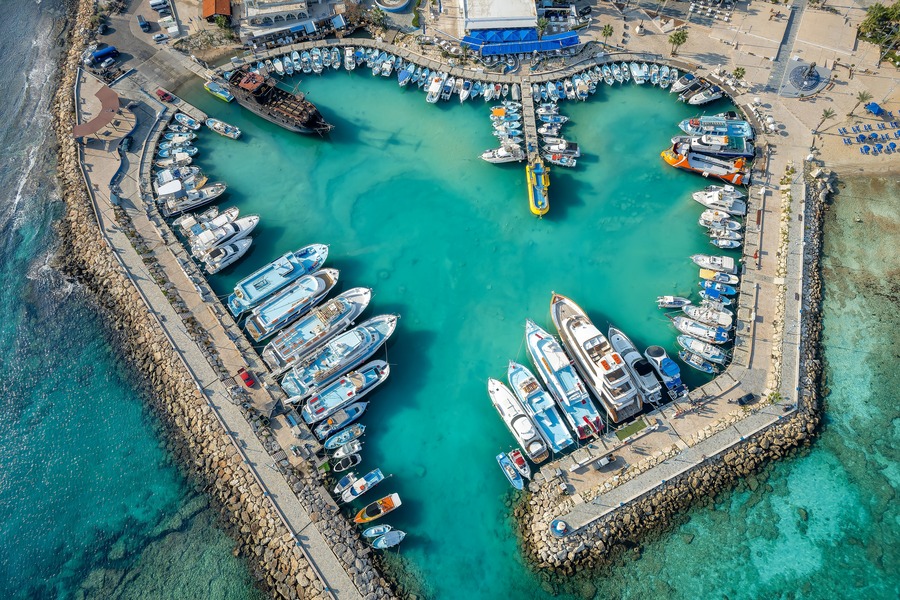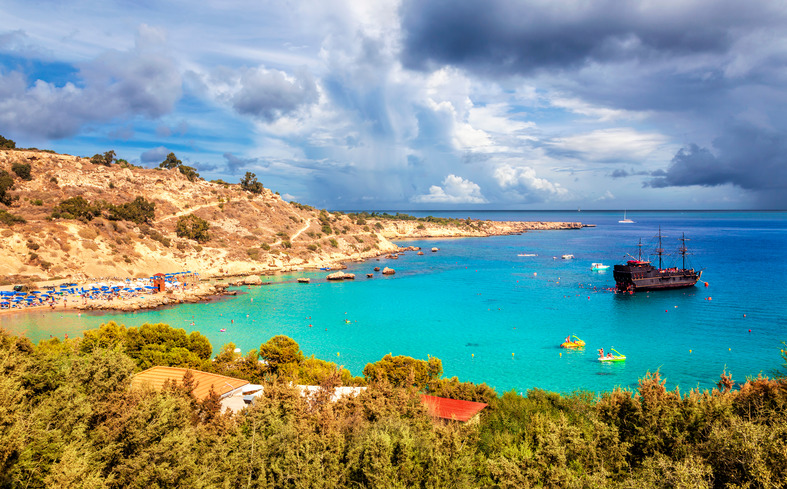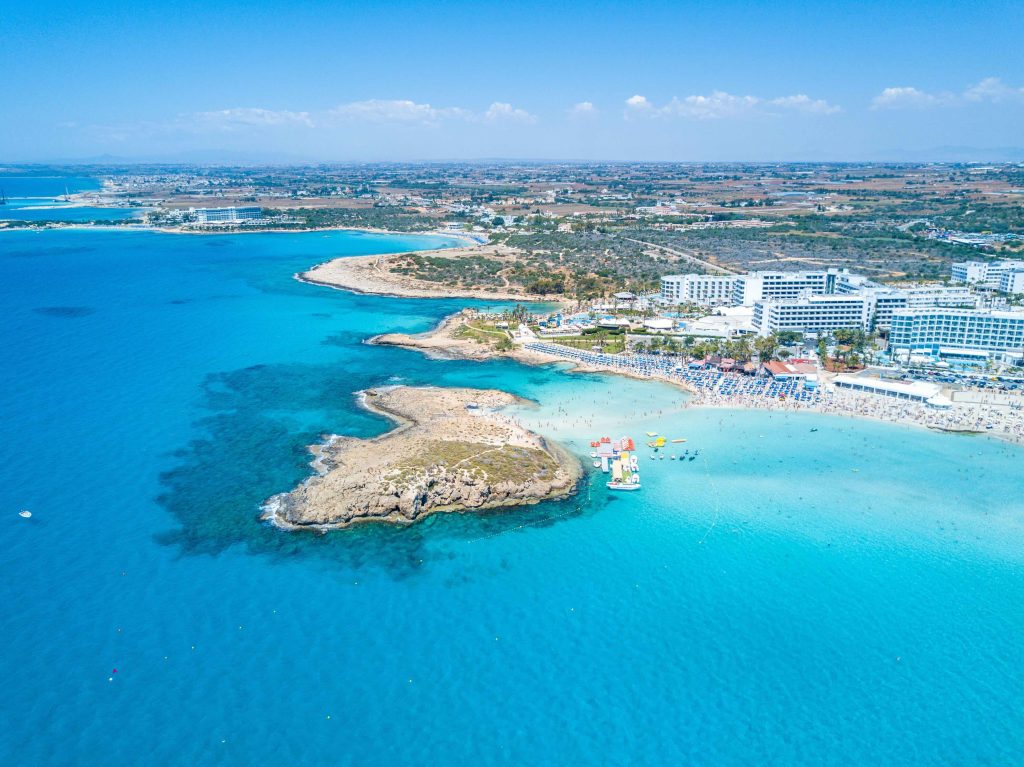About Cyprus
Cyprus is the third largest island in the Mediterranean Sea, Other neighbouring territories include Syria and Lebanon to the east, Israel to the southeast, Egypt to the south, and Greece to the northwest. The physical relief of the island is dominated by two mountain ranges, the Troodos Mountains and the smaller Troodos Mountains , and the central plain they encompass, the Mesaoria . The Mesaoria plain is drained by the Pedieos River , the longest on the island. The Troodos Mountains cover most of the southern and western portions of the island and account for roughly half its area. The highest point on Cyprus is Mount Olympus at 1,952 m (6,404 ft), located in the centre of the Troodos range. At Troodos Mountains, wild moufflons roam and cedars grow, and gem-like churches and monasteries are replete with unmatched Byzantine frescoes and icons. Ten of the finest examples are designated by UNESCO as World Heritage sites. The narrow Kyrenia Range, extending along the northern coastline, occupies substantially less area, and elevations are lower, reaching a maximum of 1,024 m (3,360 ft).
Cyprus is a haven for archaeology lovers. From Neolithic settlements more than 10,000 years old, to spectacular Greco-Roman ruins, such as the ancient seaside amphitheater of Kourion, to Crusader fortresses such as Kolossi, the list of treasures is boundless. By no means will you want to miss Pafos, a wellspring of antiquities in the west, including the mysterious Tombs of the Kings…and Roman mosaics that are so colourful, extensive and well-preserved, they are recognized by UNESCO.
Although Cyprus is the third largest island in the Mediterranean, it is surprisingly compact and easy to explore. In between rugged mountain peaks and the shimmering coast you’ll traverse untrammelled landscapes and rolling hills with vineyards that still produce the world’s oldest named dessert wine, sweet Commandaria. Linger in idyllic villages such as Omodos and Lefkara where the rhythm slows down and there’s always time for another coffee. All across Cyprus, you’ll have the opportunity to experience a distinctive cuisine composed of meze, small plates of everything from flame-grilled, delicately spiced meats to
fresh vegetables and amazing cheeses, such as the famous halloumi (the savory sheep’s cheese that grills).
With its rich past as anchor, Cyprus is also a thriving modern nation with a service economy second to none in the whole region, and the Cypriot people, worldly and warm, are only too happy to share it with you. Which means among other things, an attractive range of accommodations, luxurious hotels with both local flavour and the highest international standards, quality tourist villas, agrotourism options and more.
Cyprus’ location, coveted by empires since ancient times, is still ideal today for visiting nearby countries, such as Greece, Israel and Egypt. But with so much history to see and culture to enjoy and cuisine to savor – and with Aphrodite as your guide – you will have more reasons to stay and explore Cyprus than you might think.
General Information
Time Zone: GMT+2
International dialing code: +357
Daylight Saving Time: Each year on the last Sunday of March at 01:00 GMT (03:00 Local Time), Daylight Saving Time comes into effect in Cyprus and all clocks are advanced by one hour. On the last Sunday in October at 01:00 GMT (04:00 Local Time), Cyprus reverts to Standard Time.
Climate & Weather: Cyprus enjoys an intense Mediterranean climate, with long dry summers from mid–May to mid–October, and mild winters from December to February, which are separated by short autumn and spring seasons. The island enjoys abundant sunshine, and even in December and January, there is an average of six hours of bright sunshine per day, whilst over the six ‘summer’ months, there is an average of 11.5 hours of bright sunshine per day.
Daily temperatures during the hottest months of July and August range between 30° C on the central plain, and 24° C on the Troodos Mountains. The average maximum temperatures for these two months range between 38° C and 27° C. In January, the coolest month, the indicative daily temperature is 10° C on the central plain, and 3° C on the higher parts of the Troodos Mountains, while the average minimum temperatures are 5° C and 0° C. The average daily temperature in Cyprus in October ranges from 16°C (61°F) to 22°C (72°F). Although the days are still relatively warm, the evenings can be slightly cooler, so it is advisable to pack a light jacket or sweater for the evenings.
Spoken Languages: The official languages of the island are Greek and Turkish, whilst English is widely spoken. French, German and Russian are also spoken within the tourism industry.
Religion: Cyprus enjoys an exceedingly high level of freedom of worship. While the majority of Greek-Cypriots are Greek Orthodox Christians, other denominations are represented on the island, including Armenians, Maronites and Roman Catholics. The Turkish-Cypriot community is predominantly Muslim.
Currency: Cyprus uses the EURO currency however; banks exchange all major currencies. ATMs are located around the town and tourist resorts for cash withdrawals. Most shops, restaurants and hotels accept all major credit cards.
Currency Exchange: All banks operating in Cyprus offer foreign currency exchange services and quote the exchange rates of the Euro against all major foreign currencies daily. Foreign currency can also be exchanged at hotels. More detailed information concerning exchange rates can be obtained from the Central Bank of Cyprus.
Bank Opening Hours: Monday to Friday morning 8:00 – 14:30. Banks at Larnaca and Paphos International Airport provide exchange bureau services on a 24-hour service.
Credit Cards: Major credit cards are widely accepted throughout Cyprus, especially in major towns and tourist areas that are used for serving tourists. Visa and MasterCard are the most-accepted types of cards, with American Express, Diners Club, Maestro, Carte Blanche accepted less frequently.
Electric Current – Voltage: Power supply in Cyprus is 240 volts AC, 50Hz. Sockets are usually 13 amp, square pin in most buildings. Many hotels provide adaptors upon request from the reception.
General Shopping Hours: Shop opening hours vary depending on their type and location and whether they are located in urban, tourist or rural areas. Generally, shops will open between 07:00 – 21:00 on Monday – Saturday, but this can vary an hour or two either way, depending on the type of shop and the area it is located in. On Sunday, opening times are later, typically around 11:00, and closing times vary from 14:00 – 22:00, again depending on the type of outlet and its area.
Chemist Pharmacies / Drug Stores: They stay open during shopping hours. Late night pharmacies can be found here.
Driving Side: Driving is on the left-hand side of the road. All the international road traffic signs are in use and placed on the left-hand side of roads and highways. On roundabouts, priority is given to the right side.
Smoking: Smoking is prohibited in all indoor public places and night clubs.
Useful Phone Numbers:
- Police and all Emergencies: 112, 199
- Flight Information: 77778833
- Pharmacies after Hours: 90901415
- Doctors on Call: 90901435
Insurance: It is recommended that participants arrange insurance for medical expenses, loss and accidents occurring during the conference. The organizers cannot be held responsible for any losses, damages or injuries
About Ayia Napa
Ayia Napa is located in the eastern coast of Cyprus very closed to Famagusta City. Ayia Napa is the town of natural beauty – golden sandy beaches with crystal clear varying shades of blue waters, of history and culture with friendly and hospitable people is definitely a unique place for all of you who wish to have unforgettable vacations.
Don’t forget to visit the Monastery and the Old and New Church inside and outside of it dedicated to Virgin Mary, the Picturesque Harbor, the Municipal Museum “Thalassa”, the Makronissos Archaeological Tombs, the Venetian Aqueduct, the rural churches and chapels all around the town, the Sculpture Park, the Celebrities’ Square, the Love Bridge, and the Sculpture “I Love Ayia Napa” at the Central Square so as to take a memory photo with it.
You can visit the variety of restaurants and taverns to taste the local and international cuisine, the pubs and nightclubs for fun and pleasure and the trendy boutiques and souvenirs for shopping.



